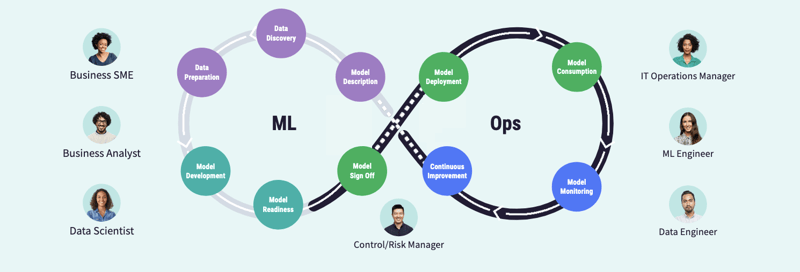Like many organizations, multinational insurance company Aviva has a lot of IT assets, processes, and support teams to manage, and they are always looking for ways to streamline their operations and improve efficiency — and do so at a rapid pace. To address these challenges, Aviva (in conjunction with Wipro) created the Digital Operations Management engine, which uses various tools and techniques to analyze and optimize its IT operations at speed.
One key component of the Digital Operations Management Engine is Dataiku, which enables Aviva to extract insights and value from its data. With Dataiku, Aviva has developed several use cases to help them better understand and manage their IT operations. For example, they've used natural language processing to classify incoming incidents and identify potential root causes with 97% accuracy.
They've also used unsupervised ML to detect anomalies in log data and alert the support team and semi-supervised learning to predict cluster failures up to three hours in advance. This blog post will highlight further ways that IT leaders can mimic this behavior when scaling analytics and AI in order to drive both resource and operational efficiency for their organizations.
The Hidden Secret: Striking the Right Balance Between Speed and Trust
In a world where digital technology is rapidly advancing, organizations are faced with the challenge of balancing the speed of innovation with the need for control. The pressure to keep up with the latest advancements can be overwhelming, but companies that learn to harness the power of AI will reap the rewards in the form of increased efficiency and business growth.
To turn AI into a true business accelerator, companies must focus on two key parameters: speed and control. By developing team autonomy, accountability, and democratizing data and AI use cases, organizations can speed up their digital transformation journey.
But rushing ahead without proper control mechanisms in place can lead to costly mistakes.

That's why it's equally important to implement calculated cost management, safety and resilience measures, and a comprehensive governance approach.
Balancing speed and control is a delicate dance. Companies that only focus on one aspect run the risk of either missing out on the benefits of AI or stifling its growth with too many restrictions. The key to success is to strike the right balance, and that means mastering both speed and control simultaneously.
By following a systematic approach that balances speed and control, IT teams can turn AI into a true business gas pedal and reap the benefits of digital technology without succumbing to its pressures. Next, we’ll outline three key parameters for IT leaders to keep front of mind on that journey:
Build an Adaptive and Future-Proof Analytics System
Just like A Formula One car designed to perform at its best in any conditions, an adaptive platform should be able to handle an increasing amount of computing power, in any configuration, without any degradation in performance.”
On the road to scaling AI, IT leaders should be sure to leverage:
- A flexible system that stands the test of time (i.e., a platform that can operate on any IT infrastructure and allow them to switch between different options if their needs change)
- Elastic computing and autoscaling for business teams (i.e., a pushdown architecture like in Dataiku that allows organizations to leverage existing, elastic, and highly scalable IT systems, including SQL databases, Spark, and Kubernetes)
- Self-service advanced analytics and AI (i.e., ensuring one platform for data and domain experts where each can work their preferred way, guaranteeing a growing platform adoption)
Accelerate Time to Value to Win Pole Position
Like a racetrack, AI scaling is not a straight line. Your data and AI journey comprises various turns: sweeping turns, hairpins, chicanes, etc. Like in car racing, navigating these turns effectively and exiting the turn at full throttle is your secret to winning the AI race. But, often, doing it right takes much time, and you never have enough of it. Here are three key ways to achieve more with less and help IT leaders accelerate time to value with AI:
- Remove roadblocks with better MLOps (i.e., consider data and AI projects under an uninterrupted cycle in Dataiku, like shown in the visual below)
- Speed up data democratization (ie., foster collaboration and reuse by sharing data assets while maintaining respect of access control)
- Boost time to value with solution accelerators (i.e., use off-the-shelf use case accelerators from Dataiku designed to reduce development time and provide inspiration for teams tackling time-to-value challenges)

Use Control and Trust to Win the Data & AI Race
As AI continues to grow in various industries, it is becoming increasingly important for organizations to have a well-functioning monitoring system in place. The stakes are high: The consequences of inadequate monitoring can be devastating, ranging from decreased performance and downtime to revenue loss and increased costs.
To scale and provide a reliable service, platform administrators need to understand how AI resources are used and to what end. This capacity planning is a critical part of systems administration, as it ensures that a system can handle future workloads without running into performance issues. To that end, Dataiku offers resource usage monitoring to give platform administrators a simplified overview of the computation resources across all used infrastructures.
Next, Dataiku offers a single view of performance in order to quell constant questions about tracking model performance, model and project prioritization, and ensuring models are attached to strategic initiatives. With Dataiku Govern, users, builders, leaders, and experts track the progress of AI projects in one centralized place. The model registry works as a central repository: It helps the teams to review the status and performance metrics of all models across multiple Dataiku instances and projects.
Since key business initiatives (customer retention, fraud detection, or claims analysis, for example) often require multiple analyses and pipelines, you can also choose to group related Dataiku projects under the larger umbrella of a business initiative; keep an eye on what matters most and review the business initiative progress in one place.
Dataiku, with its built-in model sign off capabilities, provides IT teams with the tools they need to implement a pre-defined governance framework and mandate specific stakeholders to review and approve models and analytics projects before deployment. This way, only the ones that meet the organization's requirements will be sent out to production.
Once Again, Speed and Control Are Key
As we mentioned, speed and control are critical to success in the rapidly advancing world of AI. It takes a comprehensive effort from an entire organization, particularly the IT team, to achieve AI initiative success. Speed is crucial in responding to a constantly changing environment. Streamlining processes and utilizing collaborative features allows for increased usage and faster project completion, while accelerators keep you ahead of the curve and ready to tackle new industry-specific use cases.
The IT team plays a vital role in establishing the foundation for AI success. By monitoring resources, providing centralized performance insights, and enforcing guidelines, they help ensure the organization is well-positioned to dominate the AI landscape.





